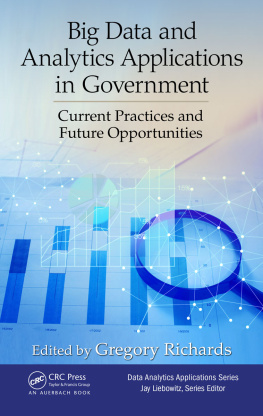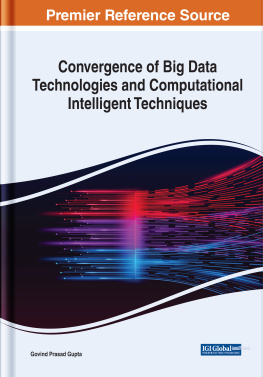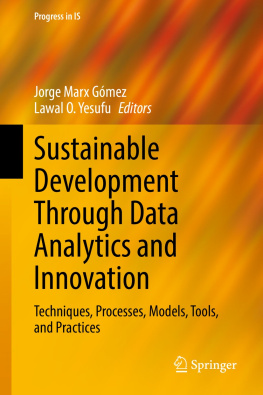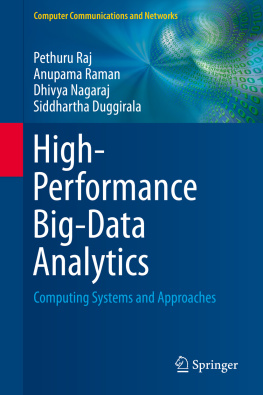Contents
Page List
Guide

Big Data and Analytics Applications in Government
Data Analytics Applications
Series Editor: Jay Liebowitz
PUBLISHED
Actionable Intelligence for Healthcare
by Jay Liebowitz, Amanda Dawson
ISBN: 978-1-4987-6665-4
Data Analytics Applications in Latin America and Emerging Economies
by Eduardo Rodriguez
ISBN: 978-1-4987-6276-2
Sport Business Analytics: Using Data to Increase Revenue and Improve Operational Efficiency
by C. Keith Harrison, Scott Bukstein
ISBN: 978-1-4987-6126-0
Big Data and Analytics Applications in Government: Current Practices and Future Opportunities
by Gregory Richards
ISBN: 978-1-4987-6434-6
Data Analytics Applications in Education
by Jan Vanthienen and Kristoff De Witte
ISBN: 978-1-4987-6927-3
FORTHCOMING
Big Data Analytics in Cybersecurity and IT Management
by Onur Savas, Julia Deng
ISBN: 978-1-4987-7212-9
Data Analytics Applications in Law
by Edward J. Walters
ISBN: 978-1-4987-6665-4
Data Analytics for Marketing and CRM
by Jie Cheng
ISBN: 978-1-4987-6424-7
Data Analytics in Institutional Trading
by Henri Waelbroeck
ISBN: 978-1-4987-7138-2
Big Data and Analytics Applications in Government
Current Practices and Future Opportunities
Edited by
Gregory Richards

CRC Press
Taylor & Francis Group
6000 Broken Sound Parkway NW, Suite 300
Boca Raton, FL 33487-2742
2018 by Taylor & Francis Group, LLC
CRC Press is an imprint of Taylor & Francis Group, an Informa business
No claim to original U.S. Government works
Printed on acid-free paper
International Standard Book Number-13: 978-1-4987-6434-6 (Hardback)
This book contains information obtained from authentic and highly regarded sources. Reasonable efforts have been made to publish reliable data and information, but the author and publisher cannot assume responsibility for the validity of all materials or the consequences of their use. The authors and publishers have attempted to trace the copyright holders of all material reproduced in this publication and apologize to copyright holders if permission to publish in this form has not been obtained. If any copyright material has not been acknowledged please write and let us know so we may rectify in any future reprint.
Except as permitted under U.S. Copyright Law, no part of this book may be reprinted, reproduced, transmitted, or utilized in any form by any electronic, mechanical, or other means, now known or hereafter invented, including photocopying, microfilming, and recording, or in any information storage or retrieval system, without written permission from the publishers.
For permission to photocopy or use material electronically from this work, please access www.copyright.com (http://www.copyright.com/) or contact the Copyright Clearance Center, Inc. (CCC), 222 Rosewood Drive, Danvers, MA 01923, 978-750-8400. CCC is a not-for-profit organization that provides licenses and registration for a variety of users. For organizations that have been granted a photocopy license by the CCC, a separate system of payment has been arranged.
Trademark Notice: Product or corporate names may be trademarks or registered trademarks, and are used only for identification and explanation without intent to infringe.
Visit the Taylor & Francis Web site at
http://www.taylorandfrancis.com
and the CRC Press Web site at
http://www.crcpress.com
Contents
MATTHEW CHEGUS
SWEE C. GOH, CATHERINE ELLIOTT, AND GREGORY RICHARDS
KHALED KHATTAB AND RAJESH K. TYAGI
ANDREW VALLERAND, ANTHONY J. MASYS, AND GARY GELING
EDUARDO RODRIGUEZ
NIKHIL VARMA AND RAJESH K. TYAGI
JULIO J. VALDES
GREGORY RICHARDS, CATHERINE ELLIOTT, AND SWEE C. GOH
OKHAIDE AKHIGBE AND DANIEL AMYOT
SEAN GEDDES AND KEVIN LAI
Why Government Analytics? Why Now?
Editors Introduction to This Volume
The Big Data phenomenon started out of necessity because of the large amounts of data generated by the Internet companies (primarily Yahoo and Google). These organizations needed to find a way to manage data continually generated by users of their search engines and so in 2004, Jeffrey Dean and Sanjay Ghemawat of Google released a paper in which they described techniques for distributed processing of large data sets. Since then, the field has grown in several directions: newer technologies that improve data capture, transformation, and dissemination have been invented as has new techniques for analyzing and generating insights. In addition, new structural models in organizations, for example, the creation of chief data officers, are being adopted to better manage data as a corporate asset.
In contrast, analytics has long been a staple of public sector organizations. Scientists working in fields such as space engineering, protection of waterways, prediction of the impact of policies, or in gathering and analyzing demographic information have for many years relied on statistical techniques to improve decision-making. Practical examples such as the United States Federal Drug Administration use of analytics for adopting a risk-based approach to inspecting manufacturing facilities, the Bureau of Indian Affairs Crime Analytics program, the use of advanced statistics in many countries for enhanced border control, and the continued growth of Compstat-style approaches pioneered in New York City attest to the widespread adoption of analytics programs within the public sector.
In many cases, however, these examples are point solutions focused on one specific area within an organization. The Big Data phenomenon has encouraged a democratization of analytics across organizations as managers learn that analytic techniques can be applied outside of strict scientific or financial contexts to improve program delivery. It is for this reason I used the term Big Data Analytics (BDA). Some analytic techniques require large data sets, but others use smaller data sets to deliver insights to program managers. In each case, it is the application of analytic techniques to data that helps to improve program delivery, not the fact that the data exists.
With these observations in mind, the first question: why government analytics? can be answered by noting that government organizations are no different to any other organization when it comes to ensuring the delivery of value for money. Managers and politicians alike seek to do the best they can often do with limited budgets working in an environment characterized by rapidly changing external conditions. Where government organizations differ from those in the private sector is in the level of complexity and ambiguity that is part and parcel of managing in public sector organizations. Within this context, BDA can be an important tool given that many analytic techniques within the Big Data world have been created specifically to deal with complexity and rapidly changing conditions. The important task for public sector organizations is to liberate analytics from narrow scientific silos and expand it across the organization to reap maximum benefit across the portfolio of programs.
The second question: why now? can be answered by realizing that up until a few years ago, a significant amount of attention was focused on simply being able to gather and process data. The tools are now available to do so. We need to turn our attention to the









![Bart Baesens [Bart Baesens] - Analytics in a Big Data World: The Essential Guide to Data Science and its Applications](/uploads/posts/book/119608/thumbs/bart-baesens-bart-baesens-analytics-in-a-big.jpg)


